This article was medically reviewed by Luba Lee, FNP-BC, MS. Luba Lee, FNP-BC is a Board-Certified Family Nurse Practitioner (FNP) and educator in Tennessee with over a decade of clinical experience. Luba has certifications in Pediatric Advanced Life Support (PALS), Emergency Medicine, Advanced Cardiac Life Support (ACLS), Team Building, and Critical Care Nursing. She received her Master of Science in Nursing (MSN) from the University of Tennessee in 2006.
There are 16 references cited in this article, which can be found at the bottom of the page.
wikiHow marks an article as reader-approved once it receives enough positive feedback. In this case, 96% of readers who voted found the article helpful, earning it our reader-approved status.
This article has been viewed 509,312 times.
If you have an inguinal hernia, one of the first things you may notice is a bulge in your abdomen or groin. This bulge may be the intestine or its contents pushing through muscles in your abdomen. Inguinal hernias are usually simple for doctors to diagnose and surgery is the primary treatment. While hernias are not often life-threatening, complications can arise if they're left untreated. In rare cases, blood supply may become cut off to the portion of intestines in the hernia. This creates a strangulated hernia, a painful condition that requires emergency surgery to prevent shock and potentially death. Learn to recognize the signs of an inguinal hernia so you can receive medical diagnosis and treatment promptly and avoid these complications.[1]
Steps
Looking for Signs of an Inguinal Hernia
-
1Look in the mirror for signs of a hernia. Remove all clothing below your waist and look in the mirror. Place two fingers over the area you think is affected. Force yourself to cough and note if you felt or saw a bulge coming out of that area. You can also hold your breath and bear down (contract your abdomen as you were going to the bathroom). Use your finger to note if a bulge is coming out. Hernias can be aggravated by doing things that put pressure on the abdomen. You should also look for:[2]
- A bulge in your groin area: If so, you may have a direct or indirect hernia.
- You will see swelling in the lower part of your abdomen that extends down toward or even into your scrotum.
- A bulge on the thigh below your groin: This is most likely a femoral hernia.
- One testicle that's larger than the other or more swollen: This may be from an indirect hernia.
- Burning, aching, or heavy pain in your groin: These can indicate a hernia because the intestine can become caught and squeezed, leading to pain. Seek emergency treatment if this occurs.
- If the swelling is an oval shape that is not in your scrotum area, then it is probably a direct hernia rather than an inguinal hernia.
-
2Check if the hernia can be pushed back. Feel if the hernia is reducible, or can be pushed back into place. Lay down to let gravity relieve the tension of the hernia back in place. Slowly apply pressure to the bulge using your index finger and try to push the contents back up. Do not force it, which could rupture the herniated products or the opening. If you can't reduce the hernia, see a healthcare professional immediately.[3]
- Let your doctor know if you've been or felt like vomiting in addition to not being able to push the bulge back in. This can mean there's a complication known as strangulation.
- You need to see a doctor immediately if you have abdominal pain or a fever.
- Strangulation of the intestine and blood vessels supplying it can deprive the intestine of proper nutrients. This will kill the tissue and keep it from functioning. You'll need surgery to remove the dead tissue so that digested products can pass through.[4]
Advertisement -
3Get a medical examination. You should get medical attention regardless of what kind of hernia you have. At the doctor's exam room, you'll need to remove all clothing below the waist and your doctor (and possibly an assistant) will inspect your abdomen and genitals for asymmetry and bulges. You'll be asked to bear down such as cough, or contract your abdomen while not breathing. A bulge suggests a hernia. Your doctor will also check to see if the hernia is reducible by palpating the area with an index finger.[5]
- Your doctor may listen against the bulge with a stethoscope for bowel sounds. If no bowel sounds are heard, this can indicate dead intestinal tissue or strangulation.[6]
-
4Learn the types of groin hernias. There are several types of hernias that affect your abdomen or groin. If you think you have a hernia in these areas, it is likely one of these:[7]
- Indirect inguinal hernia: This type is a congenital (birth) defect that causes the intestine and/or lining of the intestine to pass through the area where a man's testicles descended before birth. In most cases, this area didn't seal properly before birth, making it weak.
- Direct inguinal hernia: This type is usually caused by trauma to the area like repeated stress from lifting heavy objects, frequent coughing, straining while using the bathroom, or pregnancy. The intestine, lining, or intestinal fat pass through these weakened muscles near the groin and genitals, but not through the scrotum or testes. It is most common in men over 40, but can occur in women as well.
- Femoral hernia: This type is usually caused by pregnancy or childbirth, but can occur in men. The intestinal contents pass through a weakening in the lower groin, where the vessels supplying the thighs and legs pass through. Complications are more likely with femoral hernias, so keep your doctor up to date if symptoms change.
Treating and Recovering from an Inguinal Hernia
-
1Discuss your options with a doctor. Surgery is the most accepted and widely used treatment for hernias. But, if you're not experiencing symptoms and the hernia can be pushed back (reduced), you may want to wait. Either way, make an appointment with your doctor to get a professional opinion. If you know you'd like surgery, but your doctor advises you not to, because there aren't symptoms, you do have the right to elective surgery for cosmetic purposes. If you decide on surgery, make an appointment with a surgeon.[8]
- If you plan on surgery, you'll need to have lab work done: labs for your blood values (PT, PTT, INR, and CBC),[9] electrolytes such as sodium, potassium and glucose levels, and an ECG for detection of any heart abnormalities. Make an appointment with your primary care doctor to arrange your tests and have the results sent to your surgeon.
-
2Get laparoscopic surgery. With laparoscopic surgery, you'll be given anesthesia orally to reduce your pain and discomfort. The surgeon will inflate your abdomen with air so the tissues are more spread out and easier to work with. Next, a surgical probe is used as a camera to guide other probes that can cut, remove, and stitch. The probe will push the herniated products back in place. The probe will also apply a mesh to reinforce the weak abdominal wall. This will prevent future herniations. The small incisions from the probes will be sutured (stitched) at the end.[10]
- Laparoscopic surgery is minimally invasive. It also leaves a smaller scar after surgery, causes less blood loss, and results in less pain following surgery.
- Laparoscopic repair is favored over the open procedure if the hernia is bilateral, recurrent, or femoral.
-
3Have open surgery. If you choose to have open surgery, the surgeon will make an incision along the groin to open the area up. Once open, the surgeon will manually push the contents back into the abdomen and look for passage of flatus. Then, the surgeon will likely apply a mesh around the weak abdominal muscles or tie the abdominal muscles together. This will prevent future herniations. The incision will be sutured, or stitched, at the end.[11]
- If you have a larger hernia or are looking for a less expensive surgery, you should consider open surgery.
- Open surgical repair is favored over laparoscopic repair if there has been prior surgery in that area, if this is your first inguinal hernia, if it is a large hernia, or if infection is a concern.
-
4Care for yourself after surgery. Since you may have pain for a few weeks after the surgery, take any pain medications your doctor prescribes according to the directions. You should also make sure to eat a high-fiber diet or take 2 tablespoons (29.6 ml) of milk of magnesia twice a day following your surgery.[12] After your surgery, it will take 1 to 5 days before you have a bowel movement and a high-fiber diet can improve your bowel function.[13]
- To relieve pain, you can also place a cold pack wrapped in a towel over the area for about 20 minutes.
-
5Clean the wound. Keep the bandages over the wound for up to 2 days. You may see some bleeding or drainage from the area which is normal. After 36 hours it’s ok to take a shower. Remove the gauze before showering and apply light pressure to the area when you're washing it with soap. When you're done, lightly pat the area dry with a towel. Apply a new fresh gauze to the area after each shower.[14]
- Avoid taking baths or soaking the wound in pools or hot tubs for at least 2 weeks.
-
6Ease back into physical activity. You won't have any medical or physical restrictions after surgery, but the area may still be tender. Try to avoid any activities that apply pressure to your abdomen for about a week. These activities include exercising, running, and swimming.[15]
- You should also wait to lift anything more than 10 lbs for up to 6 weeks or till you doctor tells you it's okay. Heavy lifting can aggravate a new hernia at the same site.
- Driving is discouraged during the first two weeks after surgery.
- You can have sex after a hernia as long as it's not uncomfortable or painful.
- Most patients will have recovered and gone back to work within a month of having herniorrhaphy.
-
7Watch for complications. Talk with your doctor if you notice any of the following symptoms after your surgery:[16]
- Fever (101 F) and chills: A bacteria may have infected the surgical site.
- Drainage of fluid from the surgical area that smells or looks like pus (usually brownish/green): Bacterial infections make these smelly and viscous fluid.
- Constant bleeding from the surgical site: you may have ruptured a vessel that was never properly closed during surgery.
- Trouble urinating: Fluid and inflammation are normal after surgery, but too much can compress the bladder or urethra causing trouble urinating. This can cause urine retention or the inability to empty your bladder fully.
- Swelling or pain in testicles that's getting worse
- The most common complication is recurrence of the hernia.
Preventing Inguinal Hernias
-
1Lose weight. If you're overweight or obese, try to lose weight by eating fewer calories and doing light exercises. Excess weight can make the weak areas in your abdomen carry more weight than they should. This increased pressure on weak abdominal points can increase your likelihood of having a hernia.[17]
- Make sure to choose exercises that don't increase the stress on your abdominal wall. Good moderate exercises to try include walking, jogging, swimming and bicycling.
-
2Eat more fiber. Fiber helps move your bowels and empty your intestine. High-fiber diets also loosen your stool which will reduce straining when you go to the bathroom. Eat lots of fiber-rich foods like wheat bread, fruits and vegetables. You should also drink lots of water throughout the day to keep your bowels moving.[18]
- Fiber is especially important if you've had surgery for a hernia, because surgery and the use of pain medications can make your bowels slow down. This can lead to constipation which can aggravate your abdomen.
-
3Learn to lift objects correctly. Avoid or be careful when lifting heavy objects. You can start lifting objects over 10 pounds about 6 weeks after surgery. To properly lift, bend at the knees to lower yourself. Grasp the object you're lifting close to your body and lift up, using your knees, not your waist. This helps reduce the weight and stress on the abdomen from lifting and bending.[19]
- You may also want to wear a supportive garment around your waist. This can help support your abdominal muscles, especially when lifting.
-
4Stop smoking. Smoking is directly linked to chronic cough, which can cause and aggravate a hernia. If you've already had a hernia, it's extremely important that you avoid behaviors that can lead to another one, such as smoking.[20]
Expert Q&A
Did you know you can get expert answers for this article?
Unlock expert answers by supporting wikiHow
-
QuestionIf someone is physically active and has constant pain and a small knot on his left testicle, could it be a hernia?
 Chris M. Matsko, MDDr. Chris M. Matsko is a retired physician based in Pittsburgh, Pennsylvania. With over 25 years of medical research experience, Dr. Matsko was awarded the Pittsburgh Cornell University Leadership Award for Excellence. He holds a BS in Nutritional Science from Cornell University and an MD from the Temple University School of Medicine in 2007. Dr. Matsko earned a Research Writing Certification from the American Medical Writers Association (AMWA) in 2016 and a Medical Writing & Editing Certification from the University of Chicago in 2017.
Chris M. Matsko, MDDr. Chris M. Matsko is a retired physician based in Pittsburgh, Pennsylvania. With over 25 years of medical research experience, Dr. Matsko was awarded the Pittsburgh Cornell University Leadership Award for Excellence. He holds a BS in Nutritional Science from Cornell University and an MD from the Temple University School of Medicine in 2007. Dr. Matsko earned a Research Writing Certification from the American Medical Writers Association (AMWA) in 2016 and a Medical Writing & Editing Certification from the University of Chicago in 2017.
Family Medicine Physician
-
QuestionWhat should I do to treat a scrotal hernia?
 Chris M. Matsko, MDDr. Chris M. Matsko is a retired physician based in Pittsburgh, Pennsylvania. With over 25 years of medical research experience, Dr. Matsko was awarded the Pittsburgh Cornell University Leadership Award for Excellence. He holds a BS in Nutritional Science from Cornell University and an MD from the Temple University School of Medicine in 2007. Dr. Matsko earned a Research Writing Certification from the American Medical Writers Association (AMWA) in 2016 and a Medical Writing & Editing Certification from the University of Chicago in 2017.
Chris M. Matsko, MDDr. Chris M. Matsko is a retired physician based in Pittsburgh, Pennsylvania. With over 25 years of medical research experience, Dr. Matsko was awarded the Pittsburgh Cornell University Leadership Award for Excellence. He holds a BS in Nutritional Science from Cornell University and an MD from the Temple University School of Medicine in 2007. Dr. Matsko earned a Research Writing Certification from the American Medical Writers Association (AMWA) in 2016 and a Medical Writing & Editing Certification from the University of Chicago in 2017.
Family Medicine Physician
Warnings
- If you get a very sharp painful feeling in your testes immediately go to the doctor. This can be from a the twisting of blood vessels supplying the testicles. This can reduce blood flow to the area. If not caught in time, the lack of blood flow to the testicle can be damaging, leading to removal of the testicle.⧼thumbs_response⧽
- Bowel strangulation and bowel obstruction can occur if inguinal hernias are left untreated. These are dangerous conditions, and can be life-threatening.⧼thumbs_response⧽
- If you have a history of hernias, it is especially important to adhere to the prevention methods listed above.⧼thumbs_response⧽
References
- ↑ https://www.niddk.nih.gov/health-information/digestive-diseases/inguinal-hernia
- ↑ https://my.clevelandclinic.org/health/diseases/16266-inguinal-hernia
- ↑ https://my.clevelandclinic.org/health/diseases/16266-inguinal-hernia
- ↑ https://www.hopkinsmedicine.org/health/conditions-and-diseases/hernias/inguinal-hernia
- ↑ https://www.aafp.org/afp/2013/0615/p844.html
- ↑ Bickley L S. Chapter 13 - Male genitalia and Hernias. Bates guide to physical examination and history taking. 10th edition. 2009 Walters Kluwer Health/Lippincott Williams & Wilkins. p 503; 509-511.
- ↑ https://www.niddk.nih.gov/health-information/digestive-diseases/inguinal-hernia
- ↑ https://www.nhs.uk/conditions/inguinal-hernia-repair/
- ↑ http://www.ncbi.nlm.nih.gov/pmc/articles/PMC3488956/
- ↑ https://www.nhs.uk/conditions/inguinal-hernia-repair/what-happens/
- ↑ https://www.nhs.uk/conditions/inguinal-hernia-repair/
- ↑ https://www.uhhospitals.org/services/surgery-services/conditions-and-treatments/hernia-surgery/patient-resources/postoperative-instructions/groin-inguinal-hernias/open-inguinal-hernia-surgery-care-instructions
- ↑ https://medlineplus.gov/ency/article/007406.htm
- ↑ https://medlineplus.gov/ency/patientinstructions/000040.htm
- ↑ https://medlineplus.gov/ency/patientinstructions/000274.htm
- ↑ https://medlineplus.gov/ency/patientinstructions/000274.htm
- ↑ https://www.hopkinsmedicine.org/health/conditions-and-diseases/hernias/inguinal-hernia
- ↑ https://myhealth.alberta.ca/Health/aftercareinformation/pages/conditions.aspx?hwid=te8190&
- ↑ https://myhealth.alberta.ca/Health/pages/conditions.aspx?hwid=hw206944
- ↑ https://myhealth.alberta.ca/Health/aftercareinformation/pages/conditions.aspx?hwid=te8190&
- ↑ Inguinal Hernia Prevention. Mayoclinic. March 20, 2013. https://www.mayoclinic.org/diseases-conditions/inguinal-hernia/symptoms-causes/syc-20351547
About This Article
To recognize an inguinal hernia, start by removing your clothes from the waist down and standing in front of a mirror. Next, place two fingers over the area that you're concerned about, cough, and feel for any bulging. If you think the hernia might be in your abdomen, hold your breath, contract your stomach muscles, and check for bulging there. The bulging area may also burn or ache. It's important to see a doctor immediately if you suspect you might have a hernia, since serious complications may result if a hernia is left untreated. For tips from our medical co-author on preventing inguinal hernias, read on!
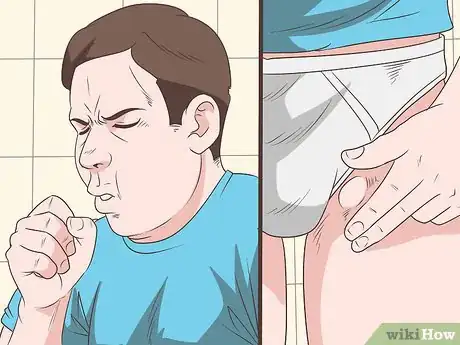
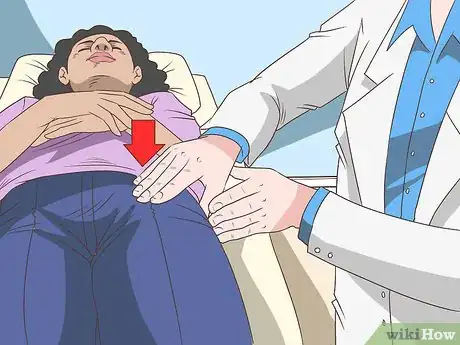
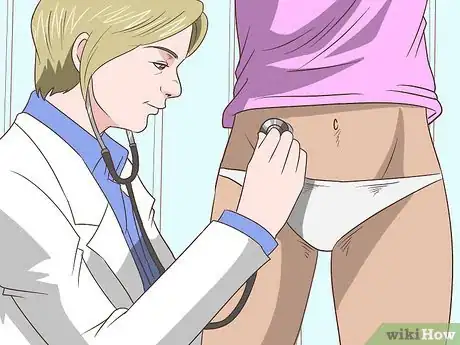
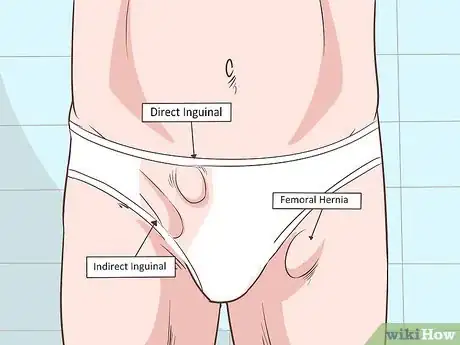

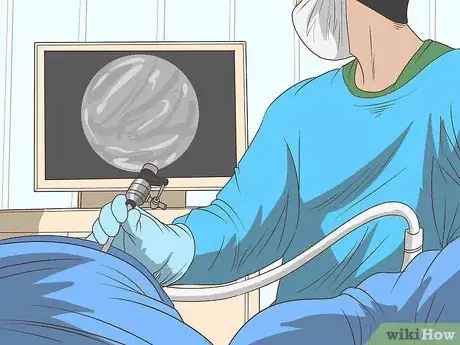
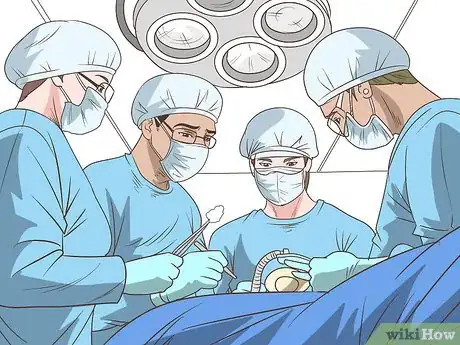
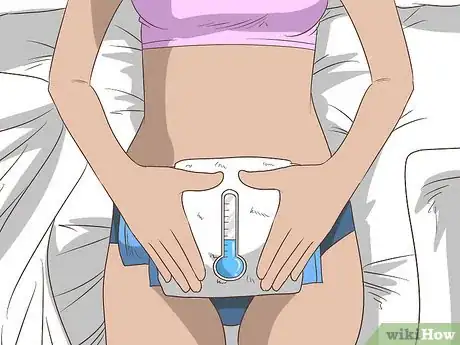
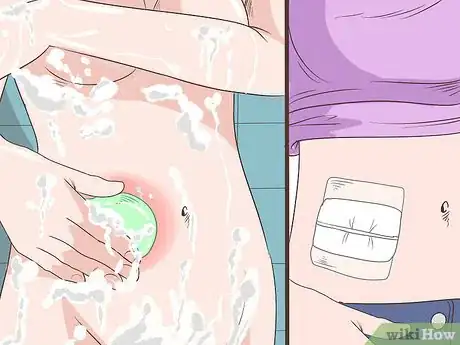
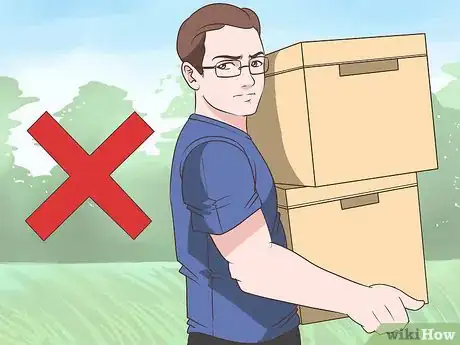
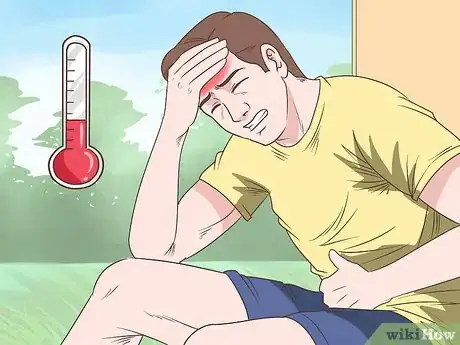
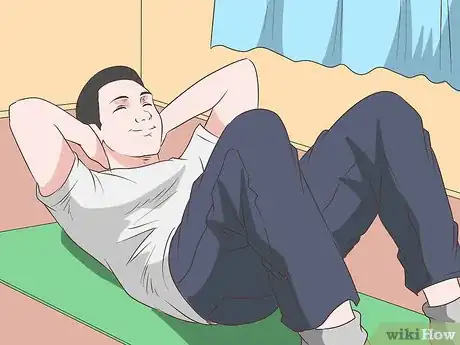

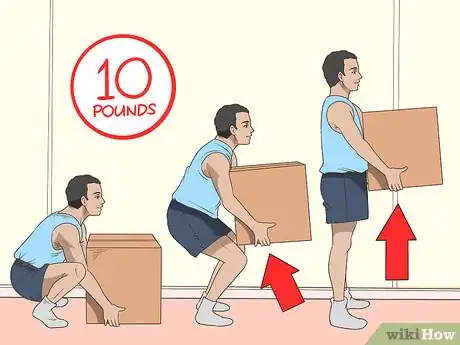
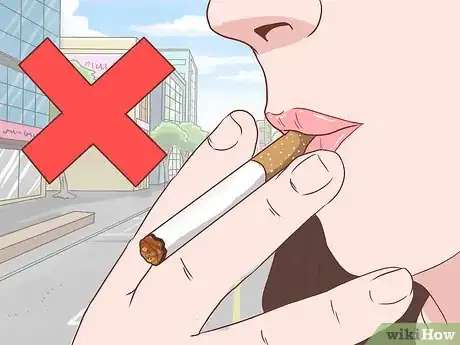

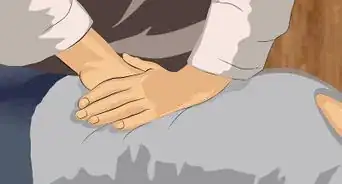


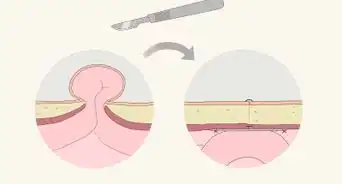
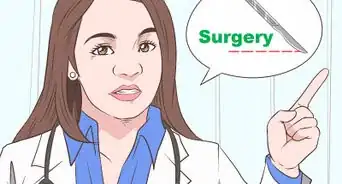

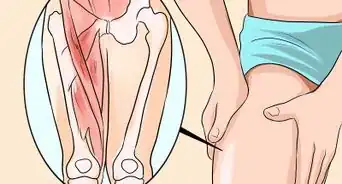


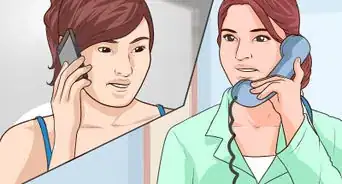
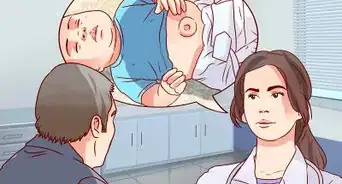










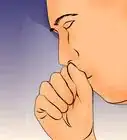
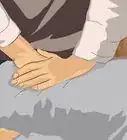






































Medical Disclaimer
The content of this article is not intended to be a substitute for professional medical advice, examination, diagnosis, or treatment. You should always contact your doctor or other qualified healthcare professional before starting, changing, or stopping any kind of health treatment.
Read More...